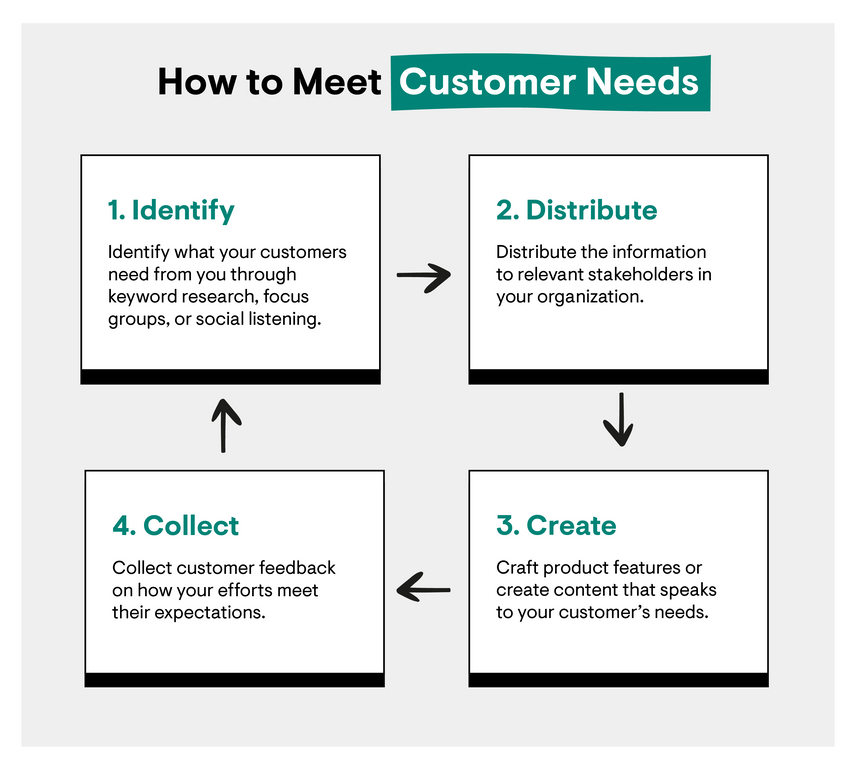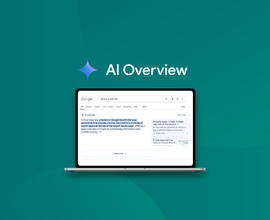Identifying and Meeting Customer Needs
Knowing your customers' needs is critical to effectively reaching and engaging with them. Learn how to find, analyze, and meet these needs using our guide.
The importance of identifying customer needs
Identifying customer needs is mission-critical for businesses looking to create a product that truly speaks to their customers’ problems. Not to mention, the easiest way to position your brand smartly in the market is to unite your internal teams behind the specific needs of your customers.
Do you feel the number of repeat buyers is low? To turn that around and grow your business, you need to learn what your customers value most. In other words, discover what makes the loyal customers loyal. Customer-centric companies are 60% more profitable than companies that don’t focus on customers.
While your business provides a solution to a need or problem, think about a typical customer’s needs from an emotional perspective. Grow your business by better understanding the audience.
4 key elements to include in a customer-first strategy:
1. Identify what the customers want
66% of customers expect companies to understand their needs and expectations. The best way to identify their needs is to take an organized approach. Some refer to this as a customer needs analysis, which provides you with valuable insights about your target audience. Common methods for discovering what customers want include focus groups, social listening, and keywordKeyword
A keyword is what users write into a search engine when they want to find something specific.
Learn more research.
2. Distribute feedback throughout your organization
Once you’ve collected data, build insights about your customers and share findings about them with your teams. Use those insights to identify opportunities for improving your products or services—and/or improving the way you describe them on your website—that make the conversionConversion
Conversions are processes in online marketing that lead to a defined conclusion.
Learn more path as easy as possible.
Conducting this type of research effort and sharing results regularly with your team will lead to more proactive, strategic, and data-oriented marketing efforts, hopefully replacing more reactive ones.
3. Create product/service features based on customer feedback
Suggestions and feedback from customers can make your products and services even better than they already are, creating loyal customers who refer their friends to your brand.
Take Groove, for example. Groove is a SaaS help desk product that had an onboarding problem in the early going. Too many people churned after signing up for a free trial because the process was confusing.
The team applied customer feedback to their onboarding process. In their first onboarding email, customers were asked a simple question: “Why did you sign up for Groove?”
The email’s response rate improved by more than 300%, and the feedback from customers helped Groove uncover features that customers wanted.
4. Collect further customer feedback on changes you’ve made based
Want to turn customers into advocates for your brand? After you’ve made improvements based on customer feedback, it’s time to return to the first step to collect further feedback on the changes you just rolled out. The customer knows best—there could be more areas for improvement or a feature that didn’t quite hit the mark. Continue meeting their needs so they feel valued.
What are customer needs?
Customer needs are the named and unnamed needs your customer has when they come in contact with your business, your competitors, or when they search for the solutions you provide.
What motivates someone to buy? Customer needs are also the features, benefits, and other intricacies that you provide. These needs often determine if the customer will buy.
Examples of customer needs for products:
- Price
- Functionality
- Design
- Experience
Examples of customer needs for services:
- Price
- Transparency
- Options
- Empathy
However, identifying the needs of your customers is easier said than done. In our experience, there are a couple of easy ways to gain insight into what your customers need from you.
How to identify customer needs
To identify the needs and wants of your customers, solicit feedback from your customers at every step of your process. You can identify customer needs in a number of ways including:
1. Conduct focus groups
A focus group is a research technique in which you interview a group of people who represent your target audience.
One of the best ways to identify and understand customer needs is to talk directly with your audience. The goal of a focus group is to foster an open dialogue with attendees—potential customers or targeted customer personas—to get a better understanding of how your customers may feel about your brand and the products or services you provide.
Can’t get people in a room together for a focus group? Try sending online surveys to collect feedback, creating online communities like Facebook and LinkedIn groups, or leveraging chatbots.
2. Use social listening
Identify which social platforms your customers are most active on and study what they talk about. What do they enjoy? What are their pain points? What questions do they ask?
Social listening is a way to monitor conversations, keywords, and hashtags that can help you identify trends and opportunities. Listening can be as simple as searching for relevant topics, or you might use a more advanced tool like social listening software to respond to new opportunities as they happen in real time.
Being at the forefront of a trending topic, hashtag, or challenge is essential to getting in front of customers at the right time. Respond to followers in an authentic manner when anyone engages with you. A fast response also allows you to provide quality customer service and encourage further interaction. Start a conversation, and people will be more likely to feel their needs are being met when they know you’re listening.
3. Do keyword research
Keyword research provides valuable insight into the questions, problems, and solutions your target audience is searching for. This analysis should be the basis for meeting your customers’ needs, helping you strategize your approach to content. Target the right keywords with effective research, and you’ll be on your way to reaching the right people.
Driving organic traffic that exemplifies your ideal customer is achieved by optimizing your website and creating content for the keywords your customers are actively searching. Some of those people will be ready to convert.
Keyword research is one of the most important tactics for identifying the needs of searchers since it helps connect the right audience to your site.
Use it to go inside the mind of your customer. What are they searching for? Why are they searching for it? Know the answers, and then you can match your content to their needs. Strong keyword research gives you direction on how to optimize your website and put your brand in front of searchers.
Anticipating customer needs
The importance of anticipating and understanding customer needs can’t be overstated. When you anticipate what your customers need from you, you can create content or expand your product features or services to meet those needs early. The earlier you meet them, the better chance you have of connecting with them before your competitors have the opportunity to.
Customers don’t part ways with brands that meet their every need. By anticipating customer needs, you can ensure that your product lines up with their expectations before they even have to ask for a new feature, service, or solution from you.
Searching based on needs
Think about how you would function as a consumer. When you have a question about a product you’re using, is your first step to call the company and ask? Or is your first step to open Google and search for the answer to your question? Most likely, it’s the latter.
That means the secret needs of your customers actually reside in how they search for your product, your company, or your services online. For this reason, keyword research will give you the earliest and most honest insight into the needs of your customers. Use it to learn directly from them. Use the voice of the customer to connect with your audience and improve their experience with you.
If you sell dishwashers, keyword research based on customer needs may lead you to phrases such as:
- Can a dishwasher run on cold water
- Dishwasher troubleshooting
- What dishwasher detergent is best for septic systems
- What is not allowed in a dishwasher
- Why dishwasher doesn’t dry
The buyer’s journey
The buyer’s journey will help you choose the keywords necessary for meeting customer needs.
The way a keyword is structured can often tell you where the searcher is in the buyer’s journey. For example, a phrase like “how to wash dishes” usually indicates the searcher is in the early stages of the buyer’s journey. They’re not necessarily looking for dishware or dish soap. They’re looking for helpful information and may not be ready to make a purchase yet.
However, “how to wash dishes” might also be a post-purchase decision if a user has purchased a dishwasher and is now looking for support on using the machine. This may then encourage you to create support content or include additional information on your product page about how to use the device. So it’s important to look at a range of results that users click on for queries you care about to determine each opportunity to reach consumers across journey stages.
A keyword like “best dishwasher with delayed start controls,” on the other hand, clearly indicates the searcher is looking for a particular type of dishwasher. They could be ready to buy.
Knowing search intent helps you understand the needs of customers. When choosing keywords to optimize your website, look for clues that could tell you what stage of the buyer’s journey the searcher might be in.
Meeting customer needs
Meeting customer needs is crucial for any business looking to retain and attract new customers. Because, as important as the discovery phase is, knowledge about what your customer needs from you is only as good as the way you use it. So, how do you meet customer needs?
This is where the going gets tough. Once you have knowledge and data about what your customer needs from you, the next step is integrating that knowledge into already existing processes. Often this can mean revamping an entire marketing campaign. You may even need to plan, build, and execute on a brand-new facet of your product. Each business will have to approach this step differently, but we’ve created a framework for how you can identify, understand, and meet customer needs.
How to meet the needs of customers
You can follow the this four-step customer needs analysis—part of the customer-first strategy mentioned earlier—to establish and meet the needs of customers:
- Identify what your customers need from you through keyword research, focus groups, or social listening.
- Distribute the information to relevant stakeholders in your organization.
- Craft product features or create content that speaks to your customer’s needs.
- Collect customer feedback on how your efforts meet their expectations.

After you’ve completed this customer needs analysis and identified what your customer needs from you, take the data you’ve collected seriously. If customers (or potential customers) are asking for something, big or small, make sure you deliver. Businesses that have a developed methodology for how they collect and share customer insights within their organization will have the best luck with meeting customer needs quickly.
That could mean assigning a dedicated team to collect customer insights. Other businesses may be able to roll it into the responsibilities of existing departments. If you develop a strong system for how you discover, analyze and address customer needs, your organization will be set up for long-term success. So, take the time and put in the legwork.
Why is it important to meet customer needs?
All of today’s most successful businesses take steps to meet customer needs early and often. For the modern marketer, taking strides to make sure your customers’ needs are met will help you align with other internal teams at your organization, like your sales team, customer support team, and your product team. With your whole organization operating under a cyclical process of anticipating, identifying, and meeting customer needs, you’ll see results in no time.
Looking for more resources?
If you’re looking to understand, identify and meet your customer’s needs, you’re already practicing customer-first marketing . What’s customer-first marketing? We’re glad you asked.
Check out our Guide to Customer-First Marketing.







